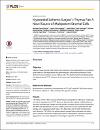Adipose tissue immunomodulation: A novel therapeutic approach in cardiovascular and metabolic diseases

View/
Date
2020-11-17Author
Alzaim, IbrahimHammoud, Safaa H.
Al-Koussa, Houssam
Ghazi, Alaa
Eid, Ali H.
El-Yazbi, Ahmed F.
...show more authors ...show less authors
Metadata
Show full item recordAbstract
Adipose tissue is a critical regulator of systemic metabolism and bodily homeostasis as it secretes a myriad of adipokines, including inflammatory and anti-inflammatory cytokines. As the main storage pool of lipids, subcutaneous and visceral adipose tissues undergo marked hypertrophy and hyperplasia in response to nutritional excess leading to hypoxia, adipokine dysregulation, and subsequent low-grade inflammation that is characterized by increased infiltration and activation of innate and adaptive immune cells. The specific localization, physiology, susceptibility to inflammation and the heterogeneity of the inflammatory cell population of each adipose depot are unique and thus dictate the possible complications of adipose tissue chronic inflammation. Several lines of evidence link visceral and particularly perivascular, pericardial, and perirenal adipose tissue inflammation to the development of metabolic syndrome, insulin resistance, type 2 diabetes and cardiovascular diseases. In addition to the implication of the immune system in the regulation of adipose tissue function, adipose tissue immune components are pivotal in detrimental or otherwise favorable adipose tissue remodeling and thermogenesis. Adipose tissue resident and infiltrating immune cells undergo metabolic and morphological adaptation based on the systemic energy status and thus a better comprehension of the metabolic regulation of immune cells in adipose tissues is pivotal to address complications of chronic adipose tissue inflammation. In this review, we discuss the role of adipose innate and adaptive immune cells across various physiological and pathophysiological states that pertain to the development or progression of cardiovascular diseases associated with metabolic disorders. Understanding such mechanisms allows for the exploitation of the adipose tissue-immune system crosstalk, exploring how the adipose immune system might be targeted as a strategy to treat cardiovascular derangements associated with metabolic dysfunctions.
Collections
- Medicine Research [1892 items ]
- Pharmacy Research [1441 items ]
Related items
Showing items related by title, author, creator and subject.
-
Myocardial ischemic subject's thymus fat: A novel source of multipotent stromal cells
Oliva-Olivera, Wilfredo; Coin-Araguez, Leticia; Salas, Julian; Lhamyani, Said; Gentile, Adriana-Mariel; Garcia, Esteban Sarria; Hmadcha, Abdelkrim; Zayed, Hatem; Vega-Rioja, Antonio; Tinahones, Francisco J.; El Bekay, Rajaa... more authors ... less authors ( Public Library of Science , 2015 , Article)Objective Adipose Tissue Stromal Cells (ASCs) have important clinical applications in the regenerative medicine, cell replacement and gene therapies. Subcutaneous Adipose Tissue (SAT) is the most common source of these ... -
Perirenal Adipose Tissue Inflammation: Novel Insights Linking Metabolic Dysfunction to Renal Diseases
Hammoud, Safaa H.; AlZaim, Ibrahim; Al-Dhaheri, Yusra; Eid, Ali H.; El-Yazbi, Ahmed F. ( Frontiers Media S.A. , 2021 , Article)A healthy adipose tissue (AT) is indispensable to human wellbeing. Among other roles, it contributes to energy homeostasis and provides insulation for internal organs. Adipocytes were previously thought to be a passive ... -
miR-21 mimic blocks obesity in mice: A novel therapeutic option
Lhamyani, Said; Gentile, Adriana-Mariel; Giráldez-Pérez, Rosa M; Feijóo-Cuaresma, Mónica; Romero-Zerbo, Silvana Yanina; Clemente-Postigo, Mercedes; Zayed, Hatem; Olivera, Wilfredo Oliva; Bermúdez-Silva, Francisco Javier; Salas, Julián; Gómez, Carlos López; Hmadcha, Abdelkrim; Hajji, Nabil; Olveira, Gabriel; Tinahones, Francisco J; El Bekay, Rajaa... more authors ... less authors ( Elsevier , 2021 , Article)MicroRNAs (miRNAs) are promising drug targets for obesity and metabolic disorders. Recently, miRNA mimics are providing a unique mechanism of action that guides the process for drug development and sets out the context of ...




